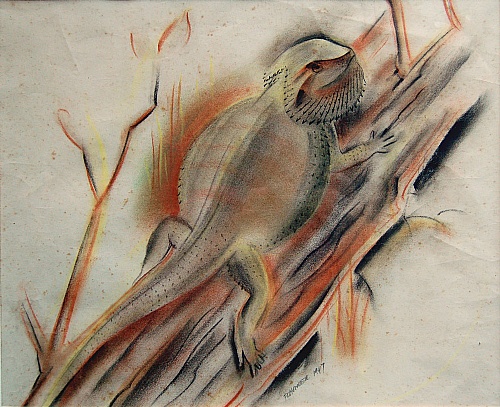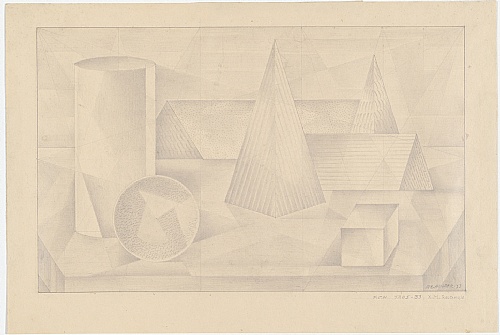HIS PHILOSOPHY
Hinder has written Through the looking-glass (without Alice) is the nearest I can come to what one has in mind - something one knows must lie beyond the realm of the accepted ‘real’, but what is it and how does one express it?
Are we all here for a certain purpose...the Scientist to discover and prove, the Philosopher to speculate, the Artist to make visible and understandable their discoveries? Hinder asked in his diary of 1938.
Looking around traditional Sydney art, he also wrote I guess the thing these artists have lost sight of is the fact that pictures are the by-products of the search for truth.
And again - Like Moses, I think, in the Promised Land, you’re always hoping to find something and what it is you just don’t know until you put it down and then you realise there’s still something else beyond that.
Early Greek philosophers pondered the problem of the One and the Many. If all things are one, how can they have different forms? What is real? In 1927 Hinder went to America in search of fundamental principles he failed to find in Sydney. Jay Hambidge’s publications on Dynamic Symmetry were part of the American turning to the Greek philosophers for answers on which to base an art for the present. Pythagoreanism dominates the books of the 1920s and early 1930s, many published in Boston and bought by Hinder - Havelock Ellis’s The Dance of Life, 1929, Irma Richter’s Rhythmic Forms in Art, 1932, Claude Bragdon’s Old Lamps for New - the ancient wisdom of the modern world, and The Frozen Fountain, 1932.
The search led Hinder to the belief in the interaction and interrelation of everything - one Supernature. Observation was his way to universality. Every action by man, beast or bird had meaning, a place in the whole. Naturalism, Semi-abstraction and Abstraction were all used to this one purpose. Hinder’s art ranged from intricately-observed lizard or frogmouth to patterns of the cosmos.

Frank Hinder, Bearded dragon 1947, pastel, 32 x 38.5 cm, © Estate of Frank Hinder

Frank Hinder, Geometric solids 1933, pencil on toned paper, 20.3 x 33 cm, Collection NGA, © Estate of Frank Hinder
His art is to do with perfecting relationships, to which his method, based originally and then ever more loosely on Dynamic Symmetry, provides a key. He made many preliminary drawings towards a final work of great complexity. Beyond the sum of the parts is the organization, the geometry, the pattern of connection. This for Hinder is the meaning of Design.
I believe that there are over a hundred systems for organizing relationships of the human figure, based on an understanding of human proportions - Hambidge was an illustrator who became interested in design in the past... He went to Greece, measuring and analyzing their art, and he got onto the use of the logarithmic spiral - I think he found the trace of a spiral at the base of a column. From that he worked out a set of proportions, to which he gave the name Dynamic Symmetry, a term similar to one used by the Greeks. It is a method of planning areas. You subdivide and relate areas geometrically...its a planned approach.
Dynamic = movement, Symmetry = relationship; Dynamic Symmetry is...concerned with the actual living movement you get in growth.
I knew that here at last was something that gave, for me, a reason and meaning to what really lay behind the statements and precepts that had previously meant nothing...don't copy - draw, don't imitate - design, analyse the anatomy, analyse the form ...It was the relationship expressed which was important, and the relationship was expressed through design - the orderly expression of an idea (Maitland Graves).